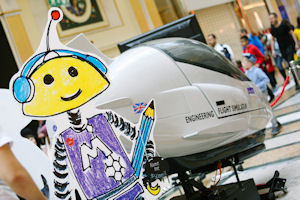#ScienceX success
25 Apr 2016
On 23 and 24 April the University took over intu Trafford Centre for the first ever #scienceX in honour of Manchester’s European City of Science title for 2016

The Faculty of Engineering and Physical Sciences worked with a team from the Faculty of Life Sciences and teamed up to bring science and engineering to a less traditional audience who they ordinarily would not normally engage with. The aim was to show both boys and girls and people of all ages that everyone has the potential to be a scientist or an engineer .
Across the two days, shoppers were wowed with a wide variety of activities, you can see many of these at Storify. Physics showed off some science tricks, discussed the use of robots in order to discover more about the universe and asked people the question “Can Physics let you see the world in a new light?” There were infrared cameras and virtual reality experiences. They also teamed up with the Square Kilometre Array (SKA) who showed displayed scale models of their radio telescope array in South Africa and Australia.
Our mechanical, aerospace and electrical engineering students let people experience their flight simulator and formula student racing car to give customers a taste of what engineers do. These were a really popular attraction of the weekend with a constant queue of excited children and adults waiting to attempt the landing of an airbus A320 or sit in the car, wear the helmet and pretend to be in the middle of an important race.
Manchester Energy demonstrated how energy is produced and guided us on the journey of how it reaches our plug sockets. Their energy pods drew interested young minds all keen to play the games they had on offer and try out the generator bike which could be used to power a fan.
Members of the public were able to hold pieces of the moon, collected by the Apollo astronauts, as well as meteorites from Mars and asteroids. They were also able to examine meteorites through microscopes to explore what they are made of. The team also demonstrated how 4.5 billion year old meteorites hold the key to understanding the history of our Solar System and how it evolved. Despite being set apart from the rest of the stands, their bold exciting banners detailing isotope and planetary science, really caught the food court’s attention and they had a steady stream of interested Trafford Centre customers keen to ‘hold the moon’.
Shoppers partied with Computer Science and their robots, and learnt how to code their behaviour, and write programs to direct their activities. The robots were voice activated and impressed everyone with their dance moves and dexterity. They could also fully immerse themselves in another world with the virtual reality headsets and search for words relating to computers and computer science.
Materials offered Electroless Copper Plating, an ‘engraving’ technique to get make a steel design using just a marker pen! They demonstrated the science behind corrosion, and how material scientists try to protect against it. They also showed off a mind controlled game where people moved rocks and trees without touching a single key on the computer key board.
Mathematicians brought statistics to life by showing people how to make a ribbon curly. They showed shoppers how different instruments create different types of curl, and how maths taught them this. Scientists from our Manchester Institute of Biotechnology presented how they study and engineer biological parts – for example sugars, enzymes and microorganisms - to help solve the problems of tomorrow and in the Sealife Centre they demonstrated some experiments to understand what carbon dioxide does to our oceans.
Visitors also had the chance to win one of 5 raspberry Pi’s and were offered the chance to come on to UoM’s Campus to learn how to program them with a real life scientist. The weekend’s Science Extravaganza was a resounding success with both visitors to the stands and those who worked on them, commenting on how much they had enjoyed the experience.
Visitors also said how pleased they were to be able to access these pieces of science and engineering which would ordinarily not be available to them and asked when we would be back again!
